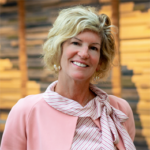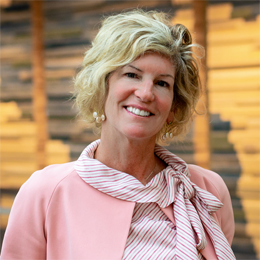By Michelle Pelletier Marshall
This article will be featured along with other articles addressing investment opportunities in agriculture and surrounding themes in the GAI Gazette, Volume 6, Issue 1, which will be distributed in conjunction with the 11th annual flagship Global AgInvesting event, held in New York City on April 1-3, 2019. Lucy MacMillan Stitzer is a featured presenter on the agenda defining sustainability for today’s consumers, producers, and investors. Learn more and register.
What do people eat? How do we help consumers make educated decisions about what they put in their grocery cart? Where is the food grown? What is the most efficient and effective way to grow and transport food while feeding a growing population using existing land? How do we connect the farmer to the consumer? Every morning, these are the questions that the Dirt to Dinner team think about when they wake up.
 Lucy MacMillan Stitzer, a member of the Cargill-MacMillan family, former Cargill board member, and founder of the Dirt to Dinner blog, has extensive experience in agriculture, banking, investments, and corporate governance. She began her career in banking, working at Citibank, Sandler O’Neill, and AmeriBank, respectively. She also served on Cargill Inc.’s Board of Directors for 18 years, contributing to the company’s future strategy and supporting efforts to advance the company’s diversity and opportunities for women. Since 2011, Stitzer has been chairman of Waycrosse, Inc., the family office of the Cargill and MacMillan families, where her primary focus is to ensure a successful future for both Cargill and the family. Throughout her career she also has benefited from direct equity investments. Today, she lives in the New York metropolitan area and serves on the board of Hamlin Capital Management, as chair/owner of Rush Creek Golf Course, and as the founder of Dirt to Dinner.
Lucy MacMillan Stitzer, a member of the Cargill-MacMillan family, former Cargill board member, and founder of the Dirt to Dinner blog, has extensive experience in agriculture, banking, investments, and corporate governance. She began her career in banking, working at Citibank, Sandler O’Neill, and AmeriBank, respectively. She also served on Cargill Inc.’s Board of Directors for 18 years, contributing to the company’s future strategy and supporting efforts to advance the company’s diversity and opportunities for women. Since 2011, Stitzer has been chairman of Waycrosse, Inc., the family office of the Cargill and MacMillan families, where her primary focus is to ensure a successful future for both Cargill and the family. Throughout her career she also has benefited from direct equity investments. Today, she lives in the New York metropolitan area and serves on the board of Hamlin Capital Management, as chair/owner of Rush Creek Golf Course, and as the founder of Dirt to Dinner.
Stitzer founded Dirt to Dinner in 2016. Frustrated by the disconnect between hard-working farmers, agriculture, and the dichotomy of what was being marketed in the grocery store, she created the consumer-based food blog. Under her direction, the site has emerged as a strong voice for the modern agricultural system and a primary resource for curious consumers. Dirt to Dinner connects both ends of that food chain – with a principal commitment to help consumers learn more about where their food comes from, as well as highlight the farmers who provide it.
The online publication focuses on global food, sustainable agriculture, and nutrition. The publication has a broad range of subject matter – from food trade and public policy, to genetic engineering and animal antibiotics, and everything in between. Perhaps the most distinctive accomplishment in our era of partisanship and hyperbole, is that Stitzer has made Dirt to Dinner a voice of solid, objective research, and sound, science-based reason, all to advance intelligent and informed consumer decision-making with regard to our global food system.
We got the chance to speak with Stitzer about her various roles in the sector.
ON HER CARGILL EXPERIENCE
1. Over 20 years ago, you were instrumental in developing the first strategies to outline the future for Cargill. Now that you can look back on them, how have they positioned the business for success?
Our strategy has been to restructure and get closer to the consumer and the farmer and bring more added value to our end customers and ultimately the consumer. We’ve continued to focus on this over the last 20 years. It’s been a slow process, but a great one.
The most exciting part of this launched in 2010. For years we had a competitive edge because we sold a high volume of commodities. Over a period of time though, a commodity is a commodity and we did not necessarily differentiate ourselves from our competitors. We realized in 1996 that this wasn’t a long-term strategy and we needed to rethink our path.
We turned our focus to building stronger relationships with our customers. We moved from simply selling a commodity, to devising solutions. Being more relationship-oriented served the company very well delivering more success, and setting the framework for today.
2. During your time with Cargill and in the agribusiness sector, what have you seen as the foundation of success?
The biggest key to success is the ability to be adaptable, flexible, and open to change – whether this be as a company, senior manager, or board member. To always be prepared and solid with great earnings, great employees and culture – but always ready to accept change.
Finally, culture is the most important lasting feature. The top companies become top firms by having a distinct, powerful, and compelling culture – a set of values, beliefs, principles, and standards – not of just professional, but also personal conduct. The culture tells you how things really get done, and how decisions are made when treading on uncertain or new territory. Cargill’s culture allows us to do that extremely well.
ON AG INVESTING
3. Based on your experiences at Cargill and your family office, what do you see as the potential impact of the world’s leading global agribusinesses working together with financial businesses in the sector?
As an agricultural community, we are only going to be effective when we work together rather than separately. That matters when your job is to feed 7.5 billion people today – and 10 billion within our children’s lifetime. It matters when we have to figure out how to get the highest yield per acre but keep our water, air, and soil clean. It is about economic and social welfare. At the end of the day, it is about a healthy planet, healthy food, and healthy people. We need diversity of thought to be able to achieve it all.
Big agribusinesses don’t always have the capital to finance everything their R&D organizations recommend, though we are seeing more of this. Cargill is investing in technology and innovation across the food and agricultural sectors. For example, recently Cargill invested in Cainthus, a startup providing cow facial recognition technology to monitor the animals’ health and other attributes to inform feeding decisions and overall animal health and welfare. Also, many other companies are coming up with new technologies. In many cases the smaller companies can move forward with innovation more quickly. We’re also seeing more partnering by big companies to collaborate and create efficiencies that benefit the larger industry.
Agribusiness provides a lot of opportunity for disruption since the sector has been buying, selling, and processing food the same way for decades, opening the door to innovative solutions. This is a great time for both the consumer and the investor, with many new technologies on the horizon, a strong focus on providing transparency in the supply chain, and varying big data solutions for the farmer and others operating in food and ag. All of these pathways are transforming ag into a more efficient, more exciting place to invest.
4. What is the guiding vision for your family office Waycrosse?
Cargill is a great company for many reasons and one of those is that it is well-owned. We are a family business and have been for 153 years. The family provides a solid foundation, values, direction, vision, and consistent ownership, which is really important. We are very supportive and have a long-term view; we are not quarter to quarter. We have very patient capital but we also have high expectations.
Waycrosse works closely with the family members, handling all financial aspects for them. We are working with the next generation to ensure they are well educated on the business as well as connected and engaged in its operations.
Our family office goal is such that we continue our sense of ownership and pride, and are excited about Cargill, in terms of protecting it and preserving it for today and for future Cargill generations of employees, stakeholders, and customers.
ON DIRT TO DINNER
5. How did your experiences influence your desire to educate consumers about food through your blog, Dirt to Dinner? What goals have you set for this media platform?
I am the mother of three children, two of whom were born with a blood disorder, inherited from my side of the family. When I asked the pediatrician the best way to keep them healthy, he said “just feed them well”. I took this to mean eat organic. So I started my own vegetable garden, made homemade baby food, and felt that I was providing my children with the healthiest foods. But as I spoke to more people from large-scale agriculture, it became clear to me that there was a huge disconnect with my approach. Sometimes organic is better and sometimes conventional farming practices are better. Sometimes integrated pest management is best. In the big basket of agricultural chemicals, some are allocated to conventional farming and some are allocated to organic. The best food all depends on the farmer’s technique and individual practices. I came to the realization that in order to feed a growing population on the same amount of land, it was a combination of different farming practices that would prove the most effective and healthy for all.
Did you know that all meat is free from antibiotics? It is against the law to process any dairy or meat where the animal has antibiotic residue. Are cage-free hens really happier? Not necessarily. Are women maturing earlier because of the hormones in milk? No, they are not. From what I see as marketing tactics in the grocery store, and what we know about food – there is a disconnect.
At Dirt to Dinner, we are always searching for the facts behind our food. Lisa Hurst, Hillary Kaufman, Caroline Breed, Hayley Philip, Garland West, and I spend hours researching, discussing, and debating different topics.
Our goal is to educate the consumer on how food is farmed and processed, and also to educate the farmer on consumer trends and purchases. If you read Dirt to Dinner you will learn whether certain foods or diets are healthy, what sustainable agriculture means, and how food makes its way around the world to come to your grocery store.
Many times, food purchases are aspirational. Consumers want full transparency to know where their food originates. But at the same time, they have an idealized emotional view of where it should come from and the two don’t always meet. You might have a farmer who grows both conventional and organic strawberries yet won’t feed his or her family GMOs because they really don’t understand what it’s all about.
Every farmer and processor has their niche and everyone looks at their ag world from their own perspective. At Dirt to Dinner, our goal is to broaden that view so that everyone understands the whole picture and can make an educated decision to ensure that we don’t have regulatory policies that prevent food from being grown and eaten in the most sustainable way
Lucy MacMillan Stitzer will be a featured speaker at Global AgInvesting 2019 in New York City, April 1-3. Learn more at www.gai-nyc.com.




